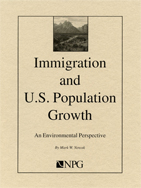Immigration and U.S. Population Growth: An Environmental Perspective
- Mark Nowak
- January 16, 1997
- Special Report
- 0 Comments

Controversy over U.S. immigration policy is by no means new to the political landscape. Since 1819, when Congress passed the first significant law regulating immigration into the United States, successive debates over immigration have stirred emotions and polarized perceptions. It is not surprising, then, to find that environmentalists, confronted by the issue with increasing frequency, are by no means in agreement about the relationship between immigration and the environment.
On the one hand are those who argue that immigration, notwithstanding the benefits it provides, is fundamentally a form of population growth. Therefore, say supporters of this position, levels of immigration must be reduced (and fertility held at replacement-level or below) if we are to move toward environmental sustainability in the United States.
Others argue that treating immigration as an environmental issue is a wrong-headed approach to environmental protection. Rather than focusing on immigration, say these proponents, the environment would be better served by addressing issues such as Americans’ hyper-consuming lifestyle, which are more to blame for our environmental ills.
It’s true that numerous factors – including the high consumption rates of Americans – contribute substantially to environmental degradation, but diminishing or discounting the real role that immigration plays makes little sense. All other factors being equal, the environmental consequences of human activity increase with the growth of the population. This essential relationship is nearly universally recognized – particularly among environmental and population groups – as one of the fundamental bases for providing international population stabilization funding.
If immigration, then, serves as a contributor to U.S. population growth, what is the basis for excluding immigration from any comprehensive analysis of the consequences of U.S. population growth? It’s time to look at and evaluate the arguments that are used against viewing immigration as a domestic population issue.”
- OUR DEMOGRAPHIC FUTURE: WHY POPULATION POLICY MATTERS TO AMERICA - June 1, 1998
- Our Demographic Future: Why Population Policy Matters to America - January 16, 1998
- Immigration and U.S. Population Growth: An Environmental Perspective (NPG Special Report) - September 1, 1997
